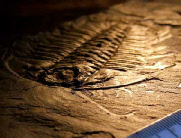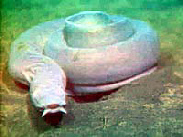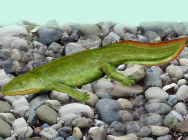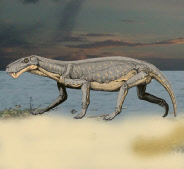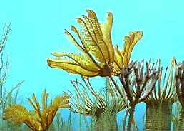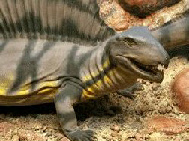
The rocks of the Abercrave Area formed during the Palaeozoic Era
It began 550 million years ago with the Cambrian Period
and ended 240 million years ago with the Permian Period
The Cambrian Period (550-510 million years ago)
This was the start of the Palaeozoic Era, but rocks of this age are only preserved in Pembrokeshire to the West and Snowdonia to the North and include the slates of Snowdonia.
During this period the first invertebrates appeared in the seas of the Earth. These were mainly tube worms and corals, animals with a plant-like appearance, which are generically known as Crinoids. They had calcareous endoskeletons consisting of individual plates, each one of which was a single calcite crystal. Crinoids flourished in the late Cambrian Period and still survive today, usually in waters over 200 metres in depth. They are known as Sea-lilies, Feather Stars, or Comatulids.
The Cribarth Mountain overlooking Abercrave is composed largely of “Mountain Limestone” which formed from the calcified remains of Crinoids.
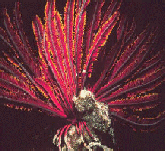
Crinoids are plant-like animals
A modern Crinoid
The Ordovician Period (510-440 million years ago)
During the Ordovician Period there was much deposition and sedimentation occurring in various depths of water in and around the Abercrave area. These events ranged from the creation of shallow water limestones and sandstones to deep water shaly mudstones containing graptolites and trilobites - two types of creature now extinct.
The Ordovician was a particularly geologically active period and to the West and North widespread volcanic deposits were being produced and the sea bed was "mobile" and rising. In the Ordovician Period the first vertebrates appeared in the seas. The land masses moved together to form the super-continent of Gondwana and sea levels rose up to 600 metres above today’s levels. The first plants began to colonise the land and the period ended in freezing conditions and massive extinctions of marine life. Sea levels fell as water was turned to ice.
A Trilobite Fossil
The Silurian Period (440-410 million years ago) deposited further shallow marine sediments ending with a period of deltaic sedimentation (coarse gritty sandstone and conglomerates). Further North there was a deep sea trough into which sediments slumped and marked the edge of what we now call the continental shelf. The Ordovician Ice began to melt, restoring sea levels, and the whole of the Northern hemisphere was covered by the vast ocean of Panthalassa.
The super-continent of Gondwana drifted Southwards and some of the land was covered by warm shallow seas. The Earth’s climate entered a warm stable period characterised by violent storms which developed as a result of high sea temperatures. The Silurian Period saw the accelerated development of the first land plants and the continued evolution of eel-like, jawless, cartilage fishes, of which the present day Hag Fish and Lamprey are descendants.
Hagfish ( Silurian Period)
The Devonian Period (410-360 million years ago) saw what is now South Wales beginning to emerge from beneath the sea and the local rocks show evidence of ripple marks and mud cracks dating from this time. These appear to have formed in shallow fresh water lakes as they contain fossil fish adapted for fresh water. The extensive sandstone deposits in the Abercrave area suggest that the newly formed dry land appeared as sand dunes and continental desert-like conditions prevailed. The first seed plants developed on land at this time, whilst in the seas, the first bony fishes appeared.
As the period progressed huge forests of seed bearing trees and plants spread across the land and as these died and became buried they took up carbon dioxide from the air, lowering the level of that greenhouse gas substantially. As the period ended temperatures were falling . Lots of tectonic activity was occurring and a new continent Euramerica (Laurussia) began colliding with Gondwana and assembling an even larger super-continent named Pangaea.
Hynerpeton. A Tetra Pod (Devonian Period)
The Carboniferous Period (360-290 million years ago) began with rising sea levels and the dry land vanished again beneath a shallow sea which deposited more marine limestones . These limestones contain the evidence of a sub-tropical climate with masses of coral preserved just where it grew. Carreg Cennen Castle to the West of Abercraf, sits majestically atop a crag of this coral deposit, with a substantial cave leading from inside the castle down into the depths of the hillside. The Western hill-side of the Swansea Valley at Abercraf, known as "Cribarth", is also limestone, but is composed largely of the skeletal remains of Crinoids, which by the time of the Carboniferous Period were common and widespread.
Sea ice formation at the poles and glaciation in Southern Gondwana caused sea levels to fall in the middle of the period and coastal flats became transformed into vast river deltas in which gritty sandstones accumulated, with inter-bedded shales on these temporary flood plains. Steep temperature gradients saw lush tropical conditions persisting relatively close to glaciated regions. Most coastal plains were colonised by vast, dense , tropical forests . The earliest amphibians began to take to the land at the beginning of the Carboniferous, whilst the lush forests with their cycle of growth and decay produced large peat deposits later in the period.
The Permian Period (290-248 million years ago) began with an ice age and produced deposits rich in gas, oil, and coal from the decay of the organic remains of the tropical carboniferous forests. The great super-continent of Pangaea straddled the Equator and stretched towards both poles. The Earth's crust was in a state of great upheaval and unrest at this time as continents were heaved up above sea level, mountain ranges thrust upwards and land masses drifted together.
Sea levels remained low during the Permian Period and large desserts formed in Pangaea. The greatest extinctions of all time occurred towards the end of the period with up to 95% of marine life and 70% of land organisms being terminated. Although amphibians declined, the land bound reptiles went through spectacular evolutionary development and carnivorous and herbivorous mammal like forms, and the forerunners of the Dinosaurs appeared. By the end of the Permian the Trilobites along with many other species were extinct. The Permian extinctions were unique in that many insects became extinct, and this indicated the severity of the environmental changes that must have taken place. Numerous theories as to to what these changes were and what caused them have been put forward. Vulcanism, meteorite impacts, eruptions of methane from the sea bed and numerous others have all failed to offer conclusive evidence as to what caused the greatest extinctions of all time. What is known is that the Permian Extinction created the niche that was to be exploited so successfully by the Dinosaurs.
Lycaenops

Sphenacodontid (Late Carboniferous)
